Pan Seared Steak
The way a steak is prepared makes all the difference in the flavor and tenderness of the meat. After making thousands of steaks at home, here are my top tips for a pan seared steak that is caramelized on the outside, and juicy in the middle. Searing steak is so easy to do, I never order it at restaurants anymore!
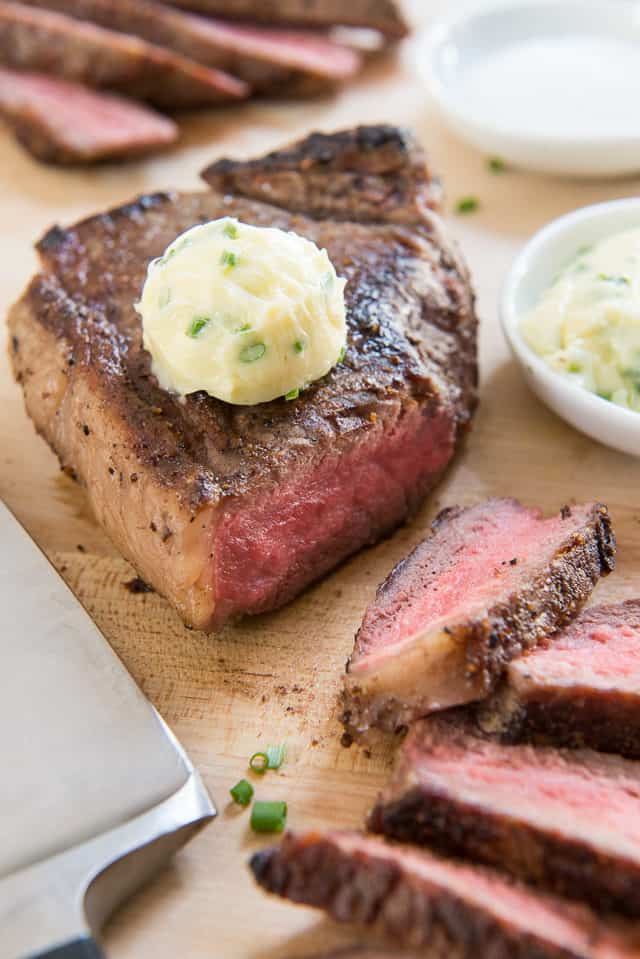
I’ve learned that a perfectly pan seared steak can be just as flavorful as anything off the grill and you can make it any time of year. We eat steak almost every day in our house, so I’ve had plenty of practice perfecting different cuts and cooking methods.
Ribeye and New York strip are my favorites, but I also buy what’s on sale, which has helped me learn how to cook and enjoy every cut of beef. When I lived in the Northeast, cold winters made grilling tricky, so I mastered cooking steak on the stove instead.
If you want to know how to pan sear steak so it’s perfectly browned on the outside and tender inside, I’ll walk you through the exact method below. And if you have leftovers, chilled slices make an amazing steak salad hearty, easy, and delicious.
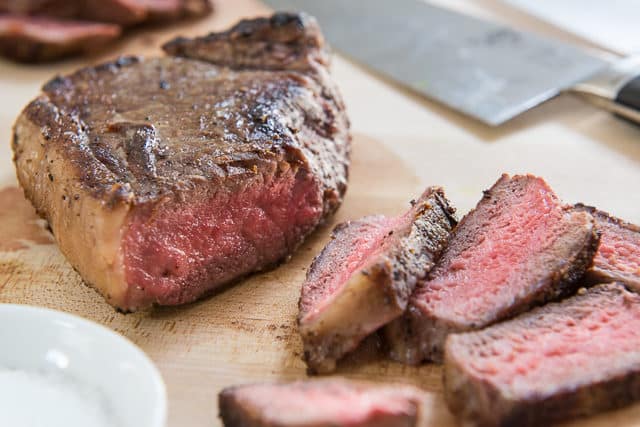
This post was originally published in January 2011, and since then I’ve seen many different methods for pan seared steak on the internet and in cookbooks. I recently experimented with a few of them to see if I liked new methods better.
The verdict? I still like this method the best.
It’s very simple and gives the results I want for perfect steak, browned outside with a rare interior.
And of course, you can cook it more if you prefer a more well done steak. A steak can truly taste incredible with just a good seasoning of salt and pepper, paired with proper searing technique.
Tips for Best Results
Take the steak out of the fridge at least an hour before cooking – This makes such a big difference that if I know I can’t take the beef out of the fridge in advance, I won’t bother making it. I have tested this many, many times and it makes a huge difference in juiciness and tenderness. This is because letting the beef warm up at room temperature means you don’t have to cook the meat as long. Your starting point is a lot higher.
Dry the steak well – Always pat the meat dry with a paper towel before searing. Before the beef can brown, any moisture on the surface must first cook off. Patting dry with a paper towel gives you a good head start on browning.
Rest the meat on a wire rack – Always rest beef for a few minutes after cooking to allow the juices to redistribute before slicing, but ideally rest it on a wire rack, which will allow the meat to retain the highest proportion of its juices. I learned this trick from Chef Rob Magee of Q39 restaurant in Kansas City, and as someone who used to put my steak on a plate that inevitably pooled with juices, it’s a great trick.
Traditional vs Grass fed Beef
I’ve cooked and eaten many different types of beef, and my preference for marbling, juiciness, and flavor is definitely traditional (aka conventional) beef. I recommend Choice grade, or even Prime, if you can afford it.
If you prefer grass fed steak, you can absolutely use this recipe. Just make sure you keep an eye on doneness, as grass fed beef cooks faster and is less forgiving if you overcook it.
Step by Step Overview:
- Temper the steaks: I take the steaks out of the fridge 60 to 120 minutes before cooking. Bringing them closer to room temperature helps them cook evenly and stay juicy. If the steak is cold, the outside will overcook before the center reaches rare or medium rare.
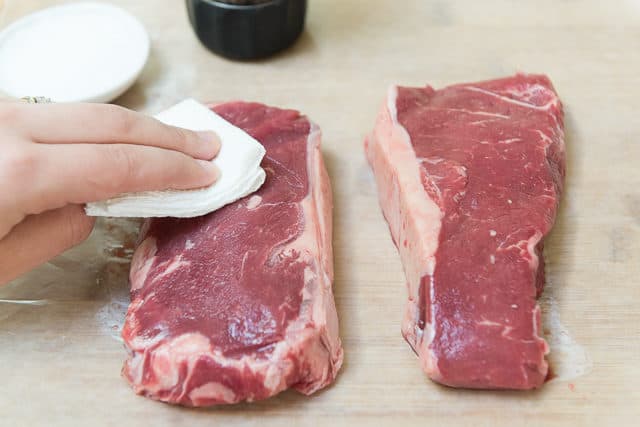
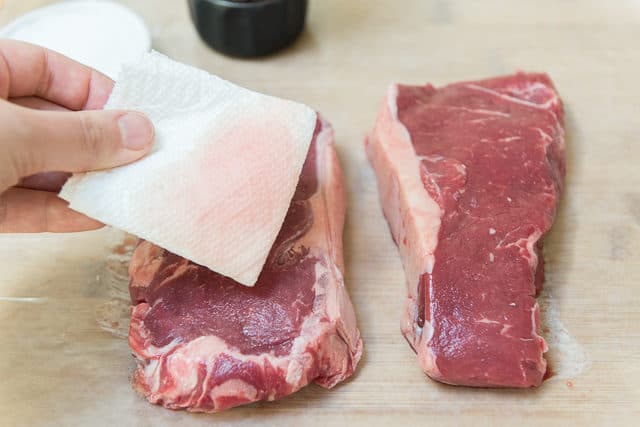
- Dry thoroughly: I set the steaks on a board and blot all sides with paper towels. It can look dry at first, but a few dabs show how much moisture is there. Surface moisture is the enemy of a deep brown crust because water must evaporate before browning can happen.
- Preheat the pan: I heat a heavy skillet over medium high until very hot. Cast iron is ideal for a steady, even sear when cooking steak on the stove.
What Kind of Pan to Use
I find cast iron to be the best for pan seared steaks because it’s naturally nonstick, it retains heat wonderfully, and the material gives a better sear than a stainless steel pan.
If you don’t have a cast iron skillet, well, you should buy one (it’s $25 and will last you a lifetime), but if you don’t have one right now, you can use any uncoated pan with good heat retention (heavy bottomed, copper core, etc). Do NOT use nonstick cookware, as the heat will be too high.
Additionally, pick a skillet that is close in size to your steak. If you use gigantic pan for a small steak, the uncovered areas will soon be covered in burned steak juices.
- Season right before searing: I season just before the steaks hit the pan so the salt does not pull out moisture. A good rule is about 3 fourths teaspoon kosher salt per pound of beef, plus a generous amount of freshly ground black pepper. Salt levels vary by brand, so adjust to taste.
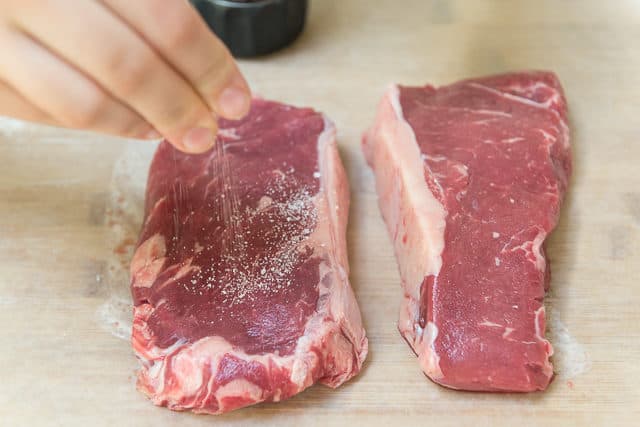

- Lightly oil the pan: I add about 1 teaspoon of high smoke point oil to the hot skillet and brush it to coat. This minimizes splatter. Beef tallow is excellent since it matches the steak fat. I avoid extra virgin olive oil here because the smoke point is too low.

- Sear the first side: I add the steaks and listen for a loud sizzle. If it is not sizzling, I pull the steaks off and let the pan heat longer. I let the first side sear undisturbed to build a deep, caramelized crust.

While the steak is cooking, don’t touch it or move it at all. This will develop a nice crust on that first side.
The steak should only be flipped one time, after that first 3-4 minute period when you check that the bottom is a beautiful golden brown color.
How Long to Sear
For a 1-inch thick steak, the beef should cook for about 3-4 minutes on each side for medium rare on a relatively high heat gas stove.
Because of variations in the strength of different stoves, it is helpful to have a thermometer, at least until you develop the ability to press a steak with your finger and know how done it is. If you press on the steak and it yields to your finger and feels soft, then it’s still rare inside. Once the meat pushes back and it feels firm, it’s cooked well done. Overall, I recommend using an instant read thermometer so you can get the internal doneness exactly to your liking.
Use the chart below to check internal temperature, and keep in mind that if you’re using grass fed beef, you should cook the meat less. Grass fed beef is much leaner and less marbled than traditional beef, and is less forgiving.
Temperature Guides for Doneness:
Keep in mind that the steaks will “cook” another 5 degrees F from carryover cooking after you remove them from the heat, so always pull them a little early.
- Rare – 125°, very red inside, cool interior
- Medium rare – 135°, red inside and warm
- Medium – 145°, pink inside and warm
- Medium well – 150°, slightly pink inside and warm
- Well – 160°, no pink inside
Make sure to use an instant-read thermometer for accuracy, inserting into the thickest part of the steak. My favorite meat thermometer is made by Meater, but Thermoworks is great too.
- Rest the steak: I transfer the steak to a rack or plate and rest for 5 minutes. Cutting too soon lets the juices spill onto the plate. Resting redistributes the juices so every bite is tender and juicy.
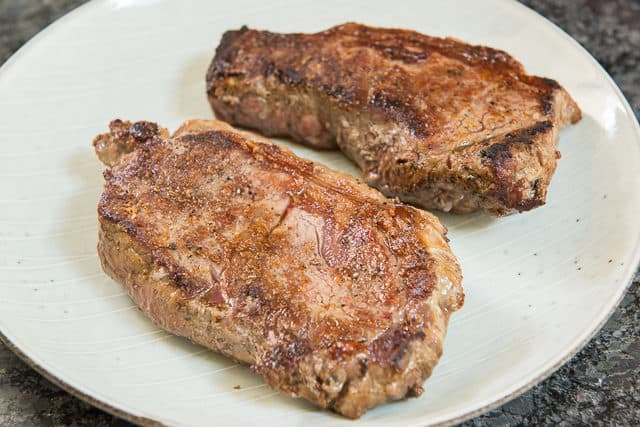
- Finish and serve: Great steak does not need much. Most nights I keep it simple with salt and pepper so I can taste the beef. Sometimes I add a small pat of butter or a quick compound butter. To make one, I mix softened salted butter with chopped chives or stir in minced garlic for garlic butter. Leftovers are fantastic thinly sliced over a steak salad.
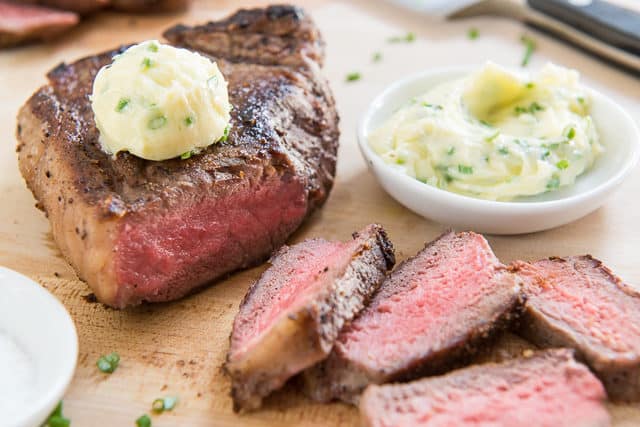
You can also consider making a quick pan sauce by adding a little bit of butter, chopped onion and garlic, and deglazing the pan with a couple tablespoons of worcestershire sauce.
Suggested Side Dish Pairings
Beef goes well with a wide array of side dishes, but here are my favorites on the blog.
- Potato Gratin – This is a classic side for beef and it’s really hearty
- Crispy Smashed Potatoes – Potatoes are the perfect pairing for steak, and these have a nice crispiness
- Steak Fries – These are really easy to make and cook in the oven, and have a nice “heft” to them
- Roasted Parsnips – A vegetable side that has a really nice flavor with the steak
- Maple Glazed Carrots – So classic with red meat, and has a lovely sweetness
- Roasted Brussel Sprouts – A healthy side option
What about thicker steaks?
If you want to prepare a thicker steak like filet mignon, then the best way to cook is to start with pan searing, then finish in the oven. If you’re doing really thick ribeyes or other cuts that are much more than 1.5″ thick, follow this rule as well.
Sear the steak as directed in the recipe below, then pop into a 400F oven to continue cooking. Timing will vary depending on the thickness and desired interior doneness, but a typical filet mignon usually needs at least 5 minutes of extra cooking in the oven.
Recipe Tips and FAQ:
Keep in an airtight container in the fridge for up to 3 days.
No, always thaw the beef first. If you’re in a hurry, you can thaw the steaks in water.
Every cut has its merits, but I tend to prefer boneless cuts here. Sometimes the bone can lift the meat away from making direct contact with the pan on the entire exterior, so it’s better suited for grilling. I love boneless ribeyes and strips best here.
Technically yes, tightly wrapped for up to 2 months, but the meat is pretty gnarly upon thawing. I recommend trying to use leftovers in something like a Steak Salad.
I recommend doing it in the pan, for a couple minutes on each side over medium heat, just enough to rewarm it. You can do it in the microwave too, but you have to watch it more closely. Cook only at 50% power in 30-second intervals.
Tried this recipe? Leave a rating and comment below — I’d love to hear how it turned out! Or, follow me on Facebook, Instagram or Pinterest!
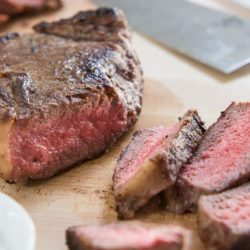
Pan Seared Steak
Ingredients
For the Steak:
- 1 ribeye steak or porterhouse, strip, etc*
- salt to taste
- black pepper to taste
- 1 teaspoon oil (tallow recommended, but any high smoke point oil, like vegetable, avocado, etc)
Ideas for What to Serve with Steak (optional):
Instructions
- 60 minutes before cooking, and a maximum of 120 minutes, remove the steak from the fridge and let sit at room temperature.
- Pat your steak as dry as you can with a paper towel.
- Heat a cast iron skillet over medium high heat for several minutes, until the pan almost begins to smoke.
- Season the steak all over with salt and pepper. I know how much salt to put on by eye, but 3/4 tsp per pound of meat using kosher salt is a good starting point.
- Use a brush to spread the oil out on the preheated skillet, then add the steak. The meat should sizzle loudly.
- Sear for 3-4 minutes on each side, until browned on the outside and medium rare on the inside.
- Let the meat rest on a wire rack or plate for at least 5 minutes after cooking. Enjoy!
Notes
Nutrition
Nutrition is estimated using a food database and is only intended to be used as a guideline for informational purposes.
This post contains affiliate links.

85 Comments on “Pan Seared Steak”
How hot is very hot?
Hi. When do you add the butter? While it’s cooking or afterwards? Thanx.
Only add it at the end, after the steak is cooked to your liking. It’s optional. Most of the time I don’t eat steak with butter.
Joanne, Tried your recipe for the first time. Unbelievable . . . so tasty . . . juicy . . . delicious . . . I can’t say enough about it. I thoroughly enjoyed every bite. No doubt that this turned out so good is because of your detailed step by step instructions. Definitely will be my favorite way to sear a steak. It is soooo good. Thank You! Justina
So happy to hear this Justina!
I pan sear steak outside on my induction cooktop in my alclad stainless frying pan. I turn it up to 10 and do about 3 minutes a side if it’s about 1.5 inches. I sauté mushrooms before the steak so the pan has some butter residue.
Your method and write up is the Best I’ve seen. Straight to the point. Tonight I’ll take mine out of the fridge and let it sit an hour.
Beyond that I will recommend that you try Longhorn Steakhouse. I agree that it’s hard to find anything as good as home but Longhorn is Incredible. Try Flo’s Filet. It is amazing! Granted I usually make ribeyes or strips but anyway it’s worth a try and being an expert you will be a good judge of their worthiness. Thanks for the article!
I made top sirloin, marinated in Yakinuku sauce in the refrigerator. Took it out for an hour before cooking on heated pan, 4 minutes each side yielded 120 internal temp. Took it off the now blackened pan and cut into thin pieces, and it turned into leather. :O( please advise how to cook if you can’t dry off the yummy sauce before cooking, or should I have???
Thanks!
I cooked 2 ribeyes just as your instructions were written. The steaks were delicious! Thank you for explaining in detail why each step was necessary. It was so simple and delicious!
I’m glad I found your recipe site. Going to try more. But again, this was so easy and delicious!
Thank you for the great tips in pan seared steaks! I have done a lot of cooking of quality meats and have seen pan seared steak. The steak is then heated on the oven. You recipe skips the oven finishing which is good.